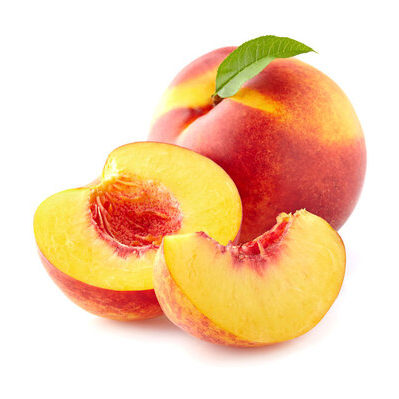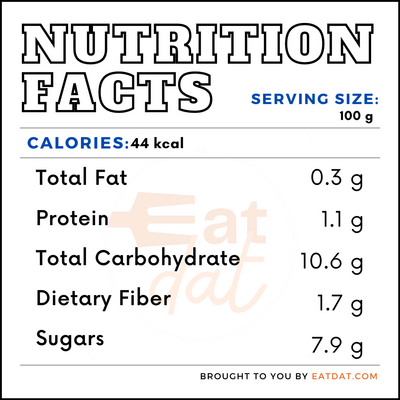
Nectarine
What is a Nectarine?
Nectarine is a type of peach which does not have fuzz. It was developed through genetic mutation from the gene of the down crossed with the gene of the smooth skin, and is genetically equivalent to the peach.
The fruit is round with a juicy pulp and has a stone in the middle. The skin is smoother than the peach, and the fruit can be eaten with or without the peel. There are hundreds of varieties of this sweet fruit grown around the world.
Some popular varieties of this fruit include:
- Arctic Jay
- Armking
- Double Delight
- Early Sungrand
- Fantasia
- Heavenly White
- La Grand
- May Grand
- Sun Home
Origin of nectarine
The origin of this fruit is not known, though it is speculated that they may have originated in China 4,000 years ago at the same time as peaches. This fruit has a smooth skin as opposed to the fuzzy skin of the peach, which biologists think is the expression of a recessive allele. They were known to be grown in ancient Greece, Persia, and ancient Rome. The word nectarine was first used in England in 1616. With the colonization of the New World, the Spanish took nectarines to the Americas.
Commercial production
This fruit requires a deep and fine loamy and sandy soil with good drainage. They are hand-harvested when the fruit is fully rounded with a golden color, in two picks a few days apart. Harvested nectarines are transported to the packing house immediately afterwards to prevent spoilage. The ripe fruit may be stored in the refrigerator for up to one week. If the fruit is unripe when purchased, it is best to keep it at room temperature until it develops a mix of red, orange, and yellow colors.
Nutrition
Nectarines are a good source of complex carbohydrates, dietary fiber, and omega-3 and omega-6 fatty acids. They contain vitamins such as vitamins A, C, E, and K, as well as B vitamins such as thiamin, riboflavin, niacin, B6, folate, and pantothenic acid. A 100g serving of nectarine contains:

In addition, the fruit contains decent levels of phosphorus, potassium, copper, and zinc. Also, it contains β-carotenoids, flavonoids, and polyphenols. Increased consumption of this fruit may result in extended lifespan, increased fertility, and a decrease in oxidative stress. Additionally, the fruit has anti-inflammatory, analgesic, and antipyretic properties.
Nectarine recipes
This fruit can be used in preparing baked goodies and desserts. They can also be used in making jams, jellies, and preserves. Some popular recipes include:
- Brown Sugar Crisp
- Upside Down Cake
- Peach Nectarine Muffins
- Fried Nectarines with Vanilla Mascarpone
- Crumb Tart
- Olive Oil Cake
- Bourbon Ice Cream Sundae
- Nectarine and Pear Marmalade
- Stir Fried Beef
- Fruit Flan
- Sticky Orange Chicken
- Rujak Buah
- Nectarine Wraps
FDA regulations
The Food & Drug Administration describes all fresh fruits, including nectarines, as raw agricultural commodities. The FDA strictly regulates all aspects of their growing, harvesting, packing, and storage.
References
Kurt Nolte, Nectarines, Yuma County Cooperative Extension https://cals.arizona.edu/fps/sites/cals.arizona.edu.fps/files/cotw/Nectarine.pdf
C. Blattný, PEACHES AND NECTARINES, Editor(s): Benjamin Caballero, Encyclopedia of Food Sciences and Nutrition (Second Edition), Academic Press, 2003, Pages 4415-4420, ISBN 9780122270550, https://doi.org/10.1016/B0-12-227055-X/00896-8.
https://www.sciencedirect.com/science/article/pii/B012227055X008968
Boyd, Olga et al. “Nectarine promotes longevity in Drosophila melanogaster.” Free radical biology & medicine vol. 50,11 (2011): 1669-78. doi:10.1016/j.freeradbiomed.2011.03.011, http://ncbi.nlm.nih.gov/pmc/articles/PMC3090488/
Elshamy, Abdelsamed Ibrahim et al. “Evaluation of Anti-inflammatory, Antinociceptive, and Antipyretic Activities of Prunus persica var. nucipersica (Nectarine) Kernel.” Planta medica vol. 85,11-12 (2019): 1016-1023. doi:10.1055/a-0955-5876, https://pubmed.ncbi.nlm.nih.gov/31212319/
